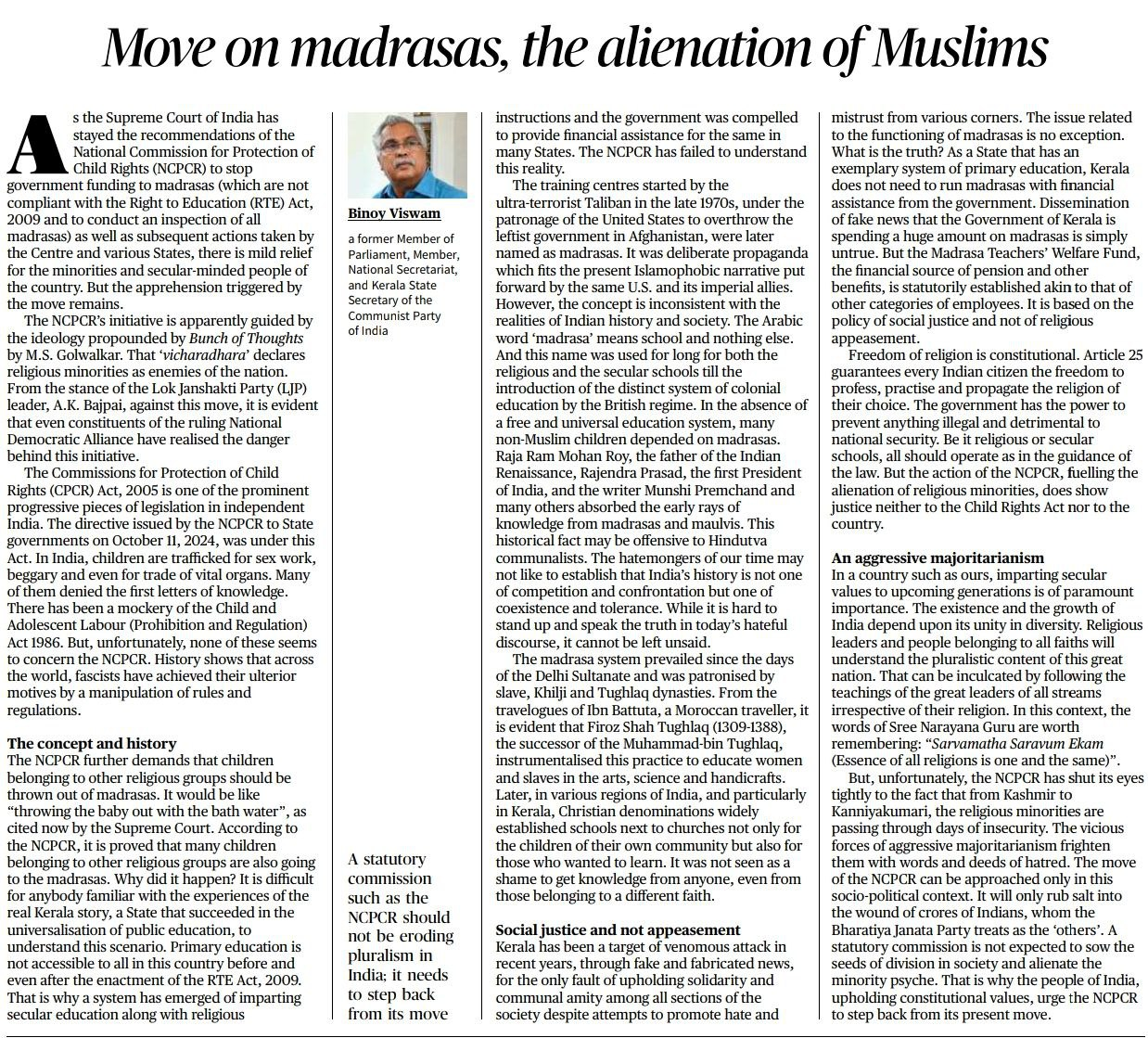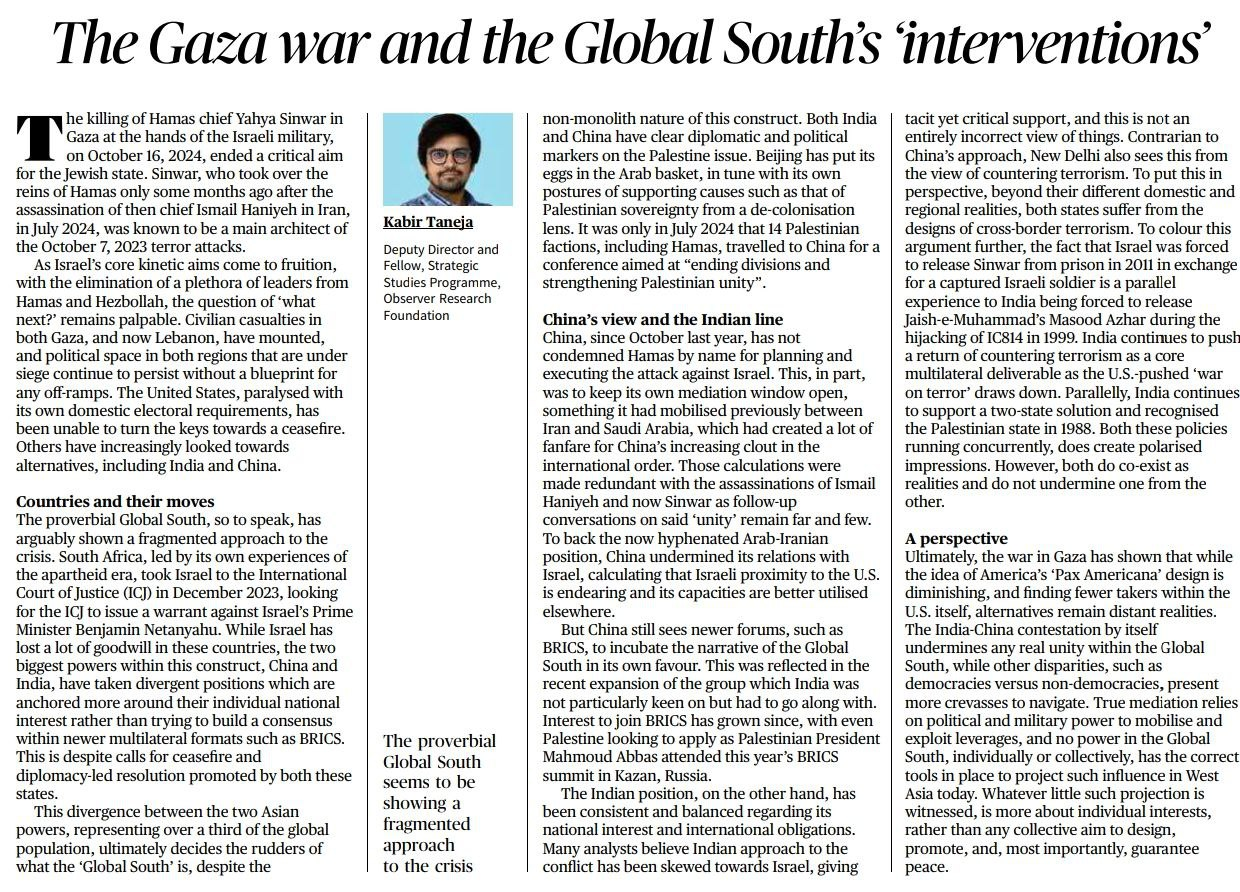The Impact of NCPCR's Madrasa Recommendations on Muslim Communities
Introduction:
- The Supreme Court of India stayed recommendations from the National Commission for Protection of Child Rights (NCPCR) to stop government funding for madrasas non-compliant with the Right to Education (RTE) Act, 2009, and to inspect all madrasas.
- The issue has sparked concerns about the alienation of Muslims and possible impacts on minorities in India.
- Background of the Issue:
- The NCPCR’s recommendation targets madrasas that do not comply with the RTE Act.
- The directive is seen by some as ideologically influenced, linked to the thoughts of S. Golwalkar and interpreted as a move against religious minorities.
- Madrasas in India have historically played a key role in education, especially for Muslim communities, providing religious and secular knowledge.
- Legal Framework:
- The Commissions for Protection of Child Rights (CPCR) Act, 2005 emphasizes the protection of children’s rights and access to education.
- Historical legislations like the Child and Adolescent Labour Act (1986) also focused on child welfare.
- The NCPCR’s stance, however, suggests an agenda that may create mistrust among Muslim communities, who rely heavily on madrasas for education.
- Madrasas and Social Justice:
- The term madrasa has been tarnished by Islamophobic narratives, often linked to terrorism, especially after the S. anti-terrorist policies.
- In reality, madrasas in India are deeply rooted in the history and culture of the country, providing vital education, particularly in Muslim-majority areas like Kerala.
- Kerala has an exemplary educational system that does not rely on government funds for madrasas, disproving claims of financial dependency.
- Concerns of Marginalization:
- The NCPCR’s move may be viewed as part of a larger trend of aggressive majoritarianism, where religious minorities like Muslims feel alienated.
- The freedom of religion enshrined in Article 25 of the Indian Constitution ensures every citizen’s right to practice their faith, but the recent recommendations may infringe upon this by targeting madrasa education.
- Historically, colonial laws and post-colonial narratives have marginalized madrasas and Muslim education, further alienating the community.
Conclusion:
- The move against madrasas raises broader questions about religious freedom and the secular fabric of India.
- It also touches upon the delicate balance between social justice, education reforms, and minority rights.
- Any policy targeting religious education, such as madrasas, must consider the cultural sensitivities of the affected communities and avoid fostering further alienation or mistrust.
Mains Practice Question
|
Q: “Discuss the role of madrasas in India’s educational landscape and critically analyze the implications of recent recommendations by the National Commission for Protection of Child Rights (NCPCR) on madrasa funding and inspection.”
|
The Gaza Conflict and Diverging Global South Responses
Introduction:
- The killing of Hamas chief Yahya Sinwar by the Israeli military in October 2024 is a major milestone in Israel’s operations following the October 2023 terror attacks.
- With rising civilian casualties and no clear path forward, political space in Gaza and Lebanon remains under siege, and the United States appears unable to push for a ceasefire.
- India and China, key members of the Global South, have stepped in with their interventions, highlighting the fragmented response of this bloc.
- Key Players and National Interests:
- The Global South’s response has been fragmented, with countries like South Africa taking Israel to the International Court of Justice (ICJ) for alleged war crimes.
- China and India, despite being part of multilateral groups like BRICS, have responded to the conflict based on their national interests rather than building a unified front.
- China aligns with Palestinian sovereignty, viewing the issue through a decolonization lens. In 2024, 14 Palestinian factions, including Hamas, were hosted in China for unity talks.
- India, balancing between counter-terrorism concerns and its historic support for Palestinian statehood, has maintained a consistent and balanced approach toward the conflict, supporting both Israel’s actions against terrorism and the two-state solution.
- Diverging Approaches:
- China has avoided directly condemning Hamas, keeping its mediation window open, particularly after its success in brokering the Iran-Saudi Arabia rapprochement.
- However, the killing of Hamas leaders like Ismail Haniyeh and Yahya Sinwar has weakened China’s efforts to position itself as a mediator in the conflict.
- India, on the other hand, draws parallels between Israel’s experience with terrorism and its own challenges, particularly citing incidents like the release of Hamas leader Sinwar in 2011 as analogous to India’s release of Masood Azhar in 1999.
- Geopolitical Implications:
- The India-China divergence reflects a broader fragmentation within the Global South, particularly on issues of democracy versus authoritarianism.
- The inability of any Global South power to project real political or military influence in West Asia undermines collective efforts at mediation and diplomacy.
- Challenges for the Global South:
- Pax Americana, the U.S.-led peace paradigm, is diminishing, leaving room for alternative mediations from the Global South. However, neither India, China, nor any collective in the South has the tools or leverage necessary to bring about a lasting solution in West Asia.
- Individual national interests, rather than a unified Global South strategy, dominate interventions in the Gaza conflict, limiting the bloc’s effectiveness.
Conclusion:
- The Gaza conflict highlights the limitations of the Global South’s diplomatic capabilities in the West Asian context. Despite the potential for a more unified approach, the competing interests of India, China, and other powers prevent the bloc from guaranteeing peace.
- This fragmentation underscores the challenges of aligning Global South powers on a common platform to influence complex geopolitical crises
Mains Practice Question |
Q: “Critically analyze the role of India and China in mediating the Gaza conflict within the context of the Global South. How do their differing approaches reflect broader geopolitical dynamics?”
|



